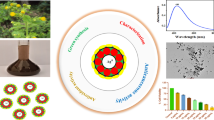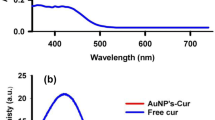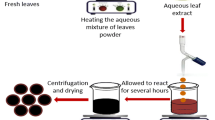Abstract
Nano-anticancer drugs are gaining importance in cancer treatment due to their unique properties and wide range of applications. The efforts are made to synthesize silver nanoparticles by a green method and used as nano-carriers for curcumin. Green synthesis of the gum-stabilized AgNPs was monitored by UV–Vis spectrophotometry and the possible interactions of gum with AgNPs were evaluated by FT-IR. The curcumin-loaded AgNPs were characterized for their size, polydispersity index, ζ potential, morphology, size distribution, drug loading efficiency, and excipients’ interactions. The prepared nano-anticancer formulations were characterized and tested for anti-cancer potentials against MM-138, FM-55 and MCF-7 cell lines, respectively. The AgNPs acted as excellent nano-carriers for an increased amount of curcumin. In in vitro anticancer study, the IC50 values for AgNPs, curcumin, and curcumin-loaded AgNPs were 166.3, 82.2 and 61.6 µg/mL; 153.2, 107.3 and 77.1 µg/mL; and 144.6, 81.2 and 60.6 µg/mL against MM-138, FM-55 and MCF-7 cell lines, respectively. It was observed that silver nanoparticles showed good loading capacity for curcumin. Also, the curcumin-loaded nanoparticles showed good anticancer activities against MM-138, FM-55 and MCF-7 cell lines, respectively. The reported nano-anticancer drug formulations may be tested in vivo studies and clinical trials for treating cancer in the future.







Similar content being viewed by others
References
Ali I (2011) Nano anti-cancer drugs: pros and cons and future perspectives. Curr Cancer Drug Targets 11:131–134
Ali I, Aboul-Enein HY, Ghanem A (2005) Enantioselective toxicities and carcinogenesis. Curr Pharm Anal 1:109–125
Ali I, Wani WA, Saleem K, Hseih MF (2013a) Design and synthesis of thalidomide based dithiocarbamate Cu(II), Ni(II) and Ru(III) complexes as anticancer agents. Polyhed 56:134–143
Ali I, Saleem K, Wesselinova D, Haque A (2013b) Synthesis, DNA binding, hemolytic and anticancer assays of curcumin I based ligands and their ruthenium (III) complexes. Med Chem Res 22:1386–1398
Ali I, Haque A, Saleem K (2014) Separation and identification of curcuminoids in turmeric powder by HPLC using phenyl column. Anal Methods 6:2526–2536
Ali I, Lone MN, Al-Othman ZA, Al-Warthan A (2015) Heterocyclic scaffolds, centrality in anticancer drug development. Curr Drug Target 16:711–734
Ali I, Lone MN, Aboul-Enein HY (2017) Imidazoles as potential anticancer agents. Med Chem Commun 8:1742–1773
Bhat ZS, Rather MA, Maqbool M, Hafiz Ullah SK, Yousuf ZA (2017) α-pyrones: small molecules with versatile structural diversity reflected in multiple pharmacological activities-an update. Biomed Pharmacother 91:265–277
Chaturvedi S, Garg A, Verma A (2020) Nano lipid based carriers for lymphatic voyage of anti-cancer drugs: an insight into the in-vitro, ex-vivo, in-situ and in-vivo study models. J Drug Deliv Sci Technol 59:101899
Chen Z et al (2013) Chitosan-Capped silver nanoparticles as a highly selective colorimetric probe for visual detection of aromatic ortho-trihydroxy phenols. Analyst 138(8):2343–2349
Dhar S et al (2008) Natural gum reduced/stabilized gold nanoparticles for drug delivery formulations. Chem Eur J 14(33):10244–10250
Dong P, Rakesh KP, Manukumar HM, Mohammed YHE, Sumathi S, Qin H-L (2019) Innovative nano-carriers in anticancer drug delivery-a comprehensive review. Bioorg Chem 85(2019):325–336
El-Khateeb E, Vasilogianni A-M, Sarah Alrubia ZM, Al-Majdoub NC, Howard M, Barber J, Rostami-Hodjegan A, Achour B (2019) Quantitative mass spectrometry-based proteomics in the era of model-informed drug development: applications in translational pharmacology and recommendations for best practice. Pharmacol Ther 203:107397
Gannimani R, Walvekar P, Naidu VR, Aminabhavi TM, Govender T (2020) Acetal containing polymers as pH-responsive nano-drug delivery systems. J Control Release 328(2020):736–761
Garg S, Garg A (2018) Encapsulation of curcumin in silver nanoparticle for enhancement of anticancer drug delivery. Int J Pharm Sci Res 9(3):1160–1166
Gindy ME, Prud’homme RK (2009) Multifunctional nanoparticles for imaging, delivery and targeting in cancer therapy. Expert Opin Drug Deliv 6(8):865–878
Gurung RB et al (2017) Synthesis of curcumin glycosides with enhanced anticancer properties using one-pot multienzyme glycosylation technique. J Microbiol Biotechnol 27(9):1639–1648
Heal DJ, Gosden J, Smith SL (2018) Evaluating the abuse potential of psychedelic drugs as part of the safety pharmacology assessment for medical use in humans. Neuropharmacology 142:89–115
Hiendrawan S, Hartanti AW, Veriansyah B, Widjojosusumo E, Tjandrawinata RR (2015) Solubility enhancement of ketoconazole via salt and cocrystal formation. Int J Pharm Pharm Sci 7:160–164
Ho C, Davies AM, Sangha RS, Lau D, Lara P Jr, Chew HK et al (2013) Phase I/II trial of pemetrexed plus nab-paclitaxel in advanced solid tumor patients with emphasis on non-small cell lung cancer. Invest New Drugs 31:1587–1591
Ignarro LJ (1971) Effects of anti-inflammatory drugs on the stability of rat liver lysosomes in vitro. Biochem Pharmacol 20(10):2847–2860
Imran M et al (2017) Double-tailed acyl glycoside niosomalnanocarrier for enhanced oral bioavailability of cefixime. Artif Cell Nanomed Biotechnol 45(7):1440–1451
Indana MK et al (2016) A novel green synthesis and characterization of silver nanoparticles using gum tragacanth and evaluation of their potential catalytic reduction activities with methylene blue and Congo red dyes. J Anal Sci Technol 7(1):19
Juby K et al (2012) Silver nanoparticle-loaded PVA/gum acacia hydrogel: synthesis, characterization and antibacterial study. Carbohydr Polymer 89(3):906–913
Khorrami S et al (2018) Selective cytotoxicity of green synthesized silver nanoparticles against the MCF-7 tumor cell line and their enhanced antioxidant and antimicrobial properties. Int J Nanomed 13:8013
Kolluru LP, Rizvi SA, D’Souza M, D’Souza MJ (2013) Formulation development of albumin based theragnostic nanoparticles as a potential delivery system for tumor targeting. J Drug Target 21:77–86
Kompella UB, Bandi N, Ayalasomayajula SP (2003) Subconjunctival nano- and microparticles sustain retinal delivery of budesonide, a corticosteroid capable of inhibiting VEGF expression. Invest Ophthalmol vis Sci 44:1192–1201
Kuttan R et al (1985) Potential anticancer activity of turmeric (Curcuma longa). Cancer Lett 29(2):197–202
Kuttan G et al (2007) Antitumor, anti-invasion, and antimetastatic effects of curcumin. The molecular targets and therapeutic uses of curcumin in health and disease. Springer, pp 173–184
Liermann J, Shinoto M, Syed M, Debus J, Herfarth K (2020) Carbon ion radiotherapy in pancreatic cancer: a review of clinical data. Radiother Oncol 147:145–150
Menon LG, Kuttan R, Kuttan G (1999) Anti-metastatic activity of curcumin and catechin. Cancer Lett 141(1–2):159–165
Mizrahi JD, Surana R, Valle JW (2020) Pancreatic cancer. The Lancet 395:2008–2020
Moore HCF (2020) Breast cancer survivorship. Semin Oncol 47:222–228
Nanam PK, Thadkala K, Chinta S, Aukunuru J (2014) Investigation of various practical techniques to enhance dissolution of ezetimibe from oral tablets. J Young Pharm 6:8–15
Polasa K et al (1992) Effect of turmeric on urinary mutagens in smokers. Mutagenesis 7(2):107–109
Pooja D et al (2014) Xanthan gum stabilized gold nanoparticles: characterization, biocompatibility, stability and cytotoxicity. Carbohydr Polymer 110:1–9
Pragna S, Mandowaraa VK, Deepak G, Shetulv P (2015) Formulation of curcuminoid loaded solid lipid nanoparticles in order to improve oral bioavailability. Int J Pharm Pharm Sci 7:278–282
Rai M, Yadav A, Gade A (2009) Silver nanoparticles as a new generation of antimicrobials. Biotechnol Adv 27(1):76–83
Rao K et al (2017) Gum tragacanth stabilized green gold nanoparticles as cargos for naringin loading: a morphological investigation through AFM. Carbohydr Polymer 174:243–252
Ravikiran AVVV, Kusuma Kumari G, Krishnamurthy PT (2020) Carbon nanotubes in drug delivery: focus on anticancer therapies. J Drug Deliv Sci Technol 59:101892
Saleem K, Wani WA, Haque A, Lone MN, Hsieh MF, AmanJairajpuri M, Ali I (2013) Synthesis, DNA binding, hemolysis assays and anticancer studies of copper(II), nickel(II) and iron(III) complexes of a pyrazoline based ligand. Future Med Chem 5:135–146
Shao J, Fang Y, Zhao R, Chen F, Yang M, Jiang J, Chen Z, Yuan X, Jia L (2020) Evolution from small molecule to nano-drug delivery systems: an emerging approach for cancer therapy of ursolic acid. Asian J Pharm Sci 15:685–700
Shishodia S, Chaturvedi MM, Aggarwal BB (2007) Role of curcumin in cancer therapy. Curr Probl Cancer 31(4):243–305
Siddiqui IA, Adhami VM, Christopher J (2012) Impact of nanotechnology in cancer: emphasis on nanochemoprevention. Int J Nanomed 7:591
Singh R, Lillard JW Jr (2009) Nanoparticle-based targeted drug delivery. Exp Mol Pathol 86(3):215–223
Smyth EC, Nilsson M, Grabsch HI, van Grieken NCT, Lordick F (2020) Gastric cancer. Lancet 396:635–648
Srimal R, Dhawan BN (1973) Pharmacology of diferuloyl methane (curcumin), a non-steroidal anti-inflammatory agent. J Pharmacy Pharmacol 25(6):447–452
Tasneem S, Liu B, Bin Li M, Choudhary I, Wang W (2019) Molecular pharmacology of inflammation: medicinal plants as anti-inflammatory agents. Pharmacol Res 139:126–140
Thadkala K, Nanam PK, Rambabu B, Sailu C, Aukunuru J (2014) Preparation and characterization of amorphous ezetimibe nanosuspensions intended for enhancement of oral bioavailability. Int J Pharm Investig 4:131–137
Venkatesham M et al (2012) Synthesis of stable silver nanoparticles using gum acacia as reducing and stabilizing agent and study of its microbial properties: a novel green approach. Int J Green Nanotechnol 4(3):199–206
Walker SM, Gautam R, Turkbey B, Malayeri A, Choyke PL (2020) Update on hereditary renal cancer and imaging implications. Radiol Clin NAm 58:951–963
Wang C et al (2017) Preparation, characterization and application of polysaccharide-based metallic nanoparticles: a review. Polymers 9(12):689
Yallapu MM, Jaggi M, Chauhan SC (2012) Curcumin nanoformulations: a future nanomedicine for cancer. Drug Discov Today 17(1–2):71–80
Yallapu MM, Jaggi M, Chauhan SC (2013) Curcumin nanomedicine: a road to cancer therapeutics. Curr Pharm Des 19(11):1994–2010
Yi Y, Tu L, Hu K, Wu W, Feng J (2015) The construction of peurarin nanocrystals and its pharmacokinetic and in vivo-in vitro correlation (IVIVC) studies on beagle dog. Coll Surf B Biointerf 133:164–170
Yi Peng Lu, Chen SY, Kang Yu, Junqing Liu Su, Zeng LY (2020) Research and development of drug delivery systems based on drug transporter and nano-formulation. Asian J Pharm Sci 15:220–236
Yoysungnoen P et al (2005) Antiangiogenic activity of curcumin in hepatocellular carcinoma cells implanted nude mice. Clin Hemoreheol Microcirc 33(2):127–135
Yu MK, Park J, Jon SJT (2012) Targeting strategies for multifunctional nanoparticles in cancer imaging and therapy. Theranostics 2(1):3
Zeinali M, Abbaspour-Ravasjani S, Ghorbani M, Soltanfam T, Santos AC, Hamishehkar H, Hamblin MR (2020) Nanovehicles for co-delivery of anticancer agents. Drug Discov Today 25:1416–1430
Zhang H, Fan T, Chen W, Li Y, Wang B (2020) Recent advances of two-dimensional materials in smart drug delivery nano-systems. Bioact Mater 5:1071–1086
Zheng Yu, Xie Q, Wang H, Yanjun Hu, Ren Bo, Li X (2020) Recent advances in plant polysaccharide-mediated nano drug delivery systems. Int J Biol Macromol 165:2668–2683
Acknowledgements
The present study was partially supported by the targeted grant from the University of Sharjah (grant no. 16010901011-P). The authors would like to thank the University of Science and Technology of Fujairah, Fujairah, UAE, and University of Sharjah, Sharjah (UAE) for their support and the research facilities provided. The authors are also grateful to Taif University Researchers Supporting Project number (TURSP-2020/44), Taif University, Taif, Saudi Arabia.
Author information
Authors and Affiliations
Corresponding author
Ethics declarations
Conflict of interest
The authors have no conflicts of interest.
Additional information
Publisher's Note
Springer Nature remains neutral with regard to jurisdictional claims in published maps and institutional affiliations.
Rights and permissions
About this article
Cite this article
Ali, I., Ahmed, S.B.M., Elhaj, B.M. et al. Enhanced anticancer activities of curcumin-loaded green gum acacia-based silver nanoparticles against melanoma and breast cancer cells. Appl Nanosci 11, 2679–2687 (2021). https://doi.org/10.1007/s13204-021-02176-w
Received:
Accepted:
Published:
Issue Date:
DOI: https://doi.org/10.1007/s13204-021-02176-w




